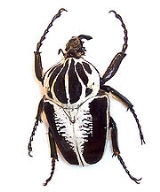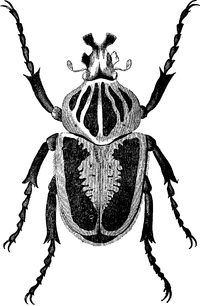
Goliathus
Encyclopedia
The Goliath beetles are among the largest insects on Earth, if measured in terms of size, bulk and weight. They are members of subfamily Cetoniinae, within the family Scarabaeidae
. Goliath beetles can be found in many of Africa
's tropical forests, where they feed primarily on tree sap
and fruit. Little appears to be known of the larval cycle in the wild, but in captivity, Goliathus beetles have been successfully reared from egg to adult using protein-rich foods such as commercial cat and dog food. Goliath beetles measure from 60 – for males and 50–80 mm (2–3.1 in) for females, as adults, and can reach weights of up to 80–100 g (2.8–3.5 oz) in the larva
l stage, though the adults are only about half this weight. The females range from a dark brown to silky white, but the males are normally brown/white/black or black/white.
 Goliathus larvae are somewhat unusual among cetoniine scarabs in that they have a greater need for high protein
Goliathus larvae are somewhat unusual among cetoniine scarabs in that they have a greater need for high protein
foods than do those of most other genera. Pellets of dry or soft dog or cat food (buried in the rearing substrate on a regular schedule) provide a suitable diet for Goliathus larvae in captivity. However, a substrate of somewhat moistened, decayed leaves and wood should still be provided in order to create a suitable medium for larval growth. The young stage larvae (1st instar) will eat some of this material. Even under optimum conditions, the larvae take a number of months to mature fully because of the great size they attain. They are capable of growing up to 250 millimetres (9.8 in) in length, and reaching weights in excess of 100 grams (3.5 oz). When maximum size is reached, the larva constructs a rather thin walled, hardened cell of sandy soil in which it will undergo metamorphosis (pupation) to the adult state. Once building of this cocoon is completed, the larva transforms to the pupa
l stage, which is an intermediate phase between the larval and adult stages. During the pupal duration, the insect's tissues are broken down and re-organized into the form of the adult beetle. Once metamorphosis is complete, the insect sheds its pupal skin and undergoes a period of hibernation as an adult beetle until the dry season ends. When the rains begin, the beetle breaks open its cocoon, locates a mate, and the entire life cycle starts over again. The adult beetles feed on materials rich in sugar
, especially tree sap
and fruit. Under captive conditions, adults can sometimes live for about a year after emerging from their pupal cells. Longevity in the wild is likely to be shorter on average due to factors such as predators and weather. The adult phase concentrates solely on reproduction, and once this function is performed, the time of the adult beetle is limited, as is true for the vast majority of other insect species.
Scarabaeidae
The family Scarabaeidae as currently defined consists of over 30,000 species of beetles worldwide. The species in this large family are often called scarabs or scarab beetles. The classification of this family is fairly unstable, with numerous competing theories, and new proposals appearing quite...
. Goliath beetles can be found in many of Africa
Africa
Africa is the world's second largest and second most populous continent, after Asia. At about 30.2 million km² including adjacent islands, it covers 6% of the Earth's total surface area and 20.4% of the total land area...
's tropical forests, where they feed primarily on tree sap
Plant sap
Sap is a fluid transported in xylem cells or phloem sieve tube elements of a plant. It transports water and nutrients throughout the plant....
and fruit. Little appears to be known of the larval cycle in the wild, but in captivity, Goliathus beetles have been successfully reared from egg to adult using protein-rich foods such as commercial cat and dog food. Goliath beetles measure from 60 – for males and 50–80 mm (2–3.1 in) for females, as adults, and can reach weights of up to 80–100 g (2.8–3.5 oz) in the larva
Larva
A larva is a distinct juvenile form many animals undergo before metamorphosis into adults. Animals with indirect development such as insects, amphibians, or cnidarians typically have a larval phase of their life cycle...
l stage, though the adults are only about half this weight. The females range from a dark brown to silky white, but the males are normally brown/white/black or black/white.
Species
There are five species of Goliath beetles, with several different subspecies and forms only partially described:- Goliathus goliatusGoliathus goliatusGoliathus goliatus is a species of beetles belonging to the Scarabaeidae family.-Synonyms:* Goliathus adspersus Sjostedt, 1927* Goliathus africanus Lamarck, 1801* Goliathus albatus Kraatz, 1897* Goliathus albipennis Endrodi, 1960...
(Linnaeus, 1771) - Goliathus albosignatus BohemanCarl Henrik BohemanCarl Henrik Boheman was a Swedish entomologist.Boheman studied at Lund University and trained as an officer, participating in the invasion of Norway in 1814...
, 1857 - Goliathus regius KlugJohann Christoph Friedrich KlugJohann Christoph Friedrich Klug was a German entomologist born 5 May 1775 in Berlin and died 3 February 1856 in the same city.He described the butterflies and some other insects of Upper Egypt and Arabia in Christian Gottfried Ehrenberg and Wilhelm Friedrich Hemprich's Symbolæ Physicæ...
, 1835 - Goliathus cacicus (Voet, 1779)
- Goliathus orientalis Moser, 1909
Habitat
All Goliathus species are native to Africa. They are primarily tropical, although one species, G. albosignatus, is localized in the more temperate southeastern portion of Africa. It is in the continent's equatorial rain forests that the Goliath beetles have reached their greatest diversity. It is also the strongest animal in the world with the rhinoceros beetle, as they can carry 850 times their own weight. In Africa, kids will tie rope around them and walk them like dogs.Life cycle

Protein
Proteins are biochemical compounds consisting of one or more polypeptides typically folded into a globular or fibrous form, facilitating a biological function. A polypeptide is a single linear polymer chain of amino acids bonded together by peptide bonds between the carboxyl and amino groups of...
foods than do those of most other genera. Pellets of dry or soft dog or cat food (buried in the rearing substrate on a regular schedule) provide a suitable diet for Goliathus larvae in captivity. However, a substrate of somewhat moistened, decayed leaves and wood should still be provided in order to create a suitable medium for larval growth. The young stage larvae (1st instar) will eat some of this material. Even under optimum conditions, the larvae take a number of months to mature fully because of the great size they attain. They are capable of growing up to 250 millimetres (9.8 in) in length, and reaching weights in excess of 100 grams (3.5 oz). When maximum size is reached, the larva constructs a rather thin walled, hardened cell of sandy soil in which it will undergo metamorphosis (pupation) to the adult state. Once building of this cocoon is completed, the larva transforms to the pupa
Pupa
A pupa is the life stage of some insects undergoing transformation. The pupal stage is found only in holometabolous insects, those that undergo a complete metamorphosis, going through four life stages; embryo, larva, pupa and imago...
l stage, which is an intermediate phase between the larval and adult stages. During the pupal duration, the insect's tissues are broken down and re-organized into the form of the adult beetle. Once metamorphosis is complete, the insect sheds its pupal skin and undergoes a period of hibernation as an adult beetle until the dry season ends. When the rains begin, the beetle breaks open its cocoon, locates a mate, and the entire life cycle starts over again. The adult beetles feed on materials rich in sugar
Sugar
Sugar is a class of edible crystalline carbohydrates, mainly sucrose, lactose, and fructose, characterized by a sweet flavor.Sucrose in its refined form primarily comes from sugar cane and sugar beet...
, especially tree sap
Sap
Sap may refer to:* Plant sap, the fluid transported in xylem cells or phloem sieve tube elements of a plant* Sap , a village in the Dunajská Streda District of Slovakia...
and fruit. Under captive conditions, adults can sometimes live for about a year after emerging from their pupal cells. Longevity in the wild is likely to be shorter on average due to factors such as predators and weather. The adult phase concentrates solely on reproduction, and once this function is performed, the time of the adult beetle is limited, as is true for the vast majority of other insect species.

